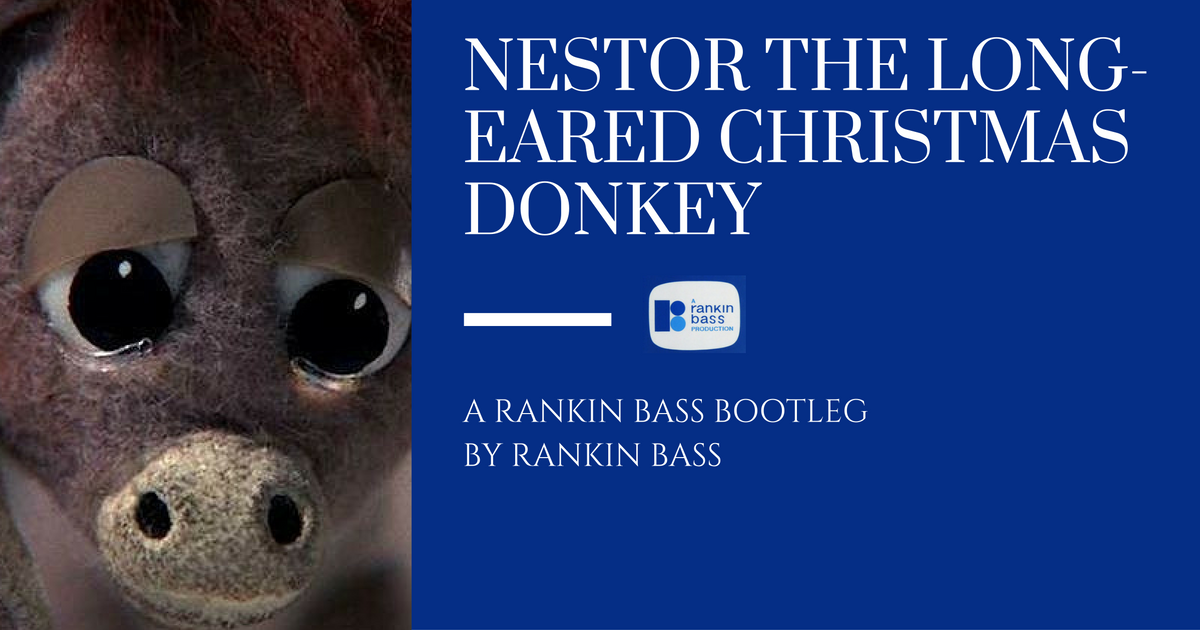
Friends, I am weakened by this special. It’s Rankin-Bass making a bootleg version of themselves and I am ashamed of them for making it. I don’t even consider it wasted potential, because the potential was really never there. Based on the song by Gene Autry, this is a special built around country music, which isn’t the bad thing! I grew up in the country. Good country music can feel real and soothing like a warm bowl of soup. Which does work for Christmas. But no special has ever left me feeling more like I just had cold canned stew than Nestor the Long-Eared Christmas Donkey.
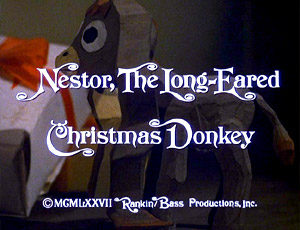
Nestor the Long-Eared Christmas Donkey is narrated by Roger Miller as Santa’s donkey Speiltoe. You know, Santa’s donkey. He pulls Santa’s snow plow. That’s a thing! I mean… no. No, it’s not. Speiltoe exists to be the missing link between Santa and Jesus. This is the first time Rankin-Bass manipulatively built something to so much of a specific purpose. Obviously Nestor the Long-Eared Christmas Donkey falls on the religious side of Rankin-Bass specials, in line with The Little Drummer Boy. Looking back at The Little Drummer Boy, I consider it a failure. It got a sequel in 1976, one that, get this, was nominated for an Emmy, but I still consider it a failure, and I bet there were many critics of the time that shared by view, because it never really gave you anything to latch onto. How do you fix that? Make it Rudolph the Red-Nosed Reindeer! Like the ‘cool’ youth group pastor who sits backwards in his chair and tries to reach the teens, it pretends to be another fun seasonal tale of misfits in Santa’s village, but really, it’s here to preach. Nestor is Rudolph. He’s just Rudolph if he hung around with Jesus. And that’s terrible by design.
As a character, Nestor is another oddball shunned by his community for having long ears. The casual bigotry of someone born with a physical disfigurement hurts Nestor just as much as it did Rudolph, but the ears make him as cute as Dumbo. Apart from one line, he also doesn’t speak… like in Dumbo. The farm owner Olaf mistreats him, but Nestor’s mother loves and protects him in another theft from Dumbo, and I think you get the picture. Not only content with ripping off themselves, Rankin-Bass took the opportunity to steal from Disney too.
Nestor’s only happy times at the donkey farm are during the Winter Solstice. There’s peace and goodwill and the exchanging of simple gifts. It seems odd to me that Rankin-Bass would be acknowledging a pagan holiday. I mean, we’ve seen specials that dealt in nostalgia before, but this is the first one to long for those simpler pre-biblical times. Everyone is immediately nice to Nestor on this day, so it actually weakens the outcast story, because now Nestor has known inclusion and happiness.
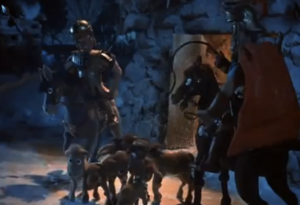
But even that happiness is soon to be ripped away because Nestor is also a donkey living in the shadow of the Great Roman Empire. F**king Romans, man. They show up and decide, for no real good reason, that all the donkeys ought to belong to them. Living with a history nerd, I’ve grown fond of seeing the Romans repeatedly presented as villains. Like Sombertown in Santa Claus is Comin’ to Town, biblical Rome is clearly rife with fascism, but Nestor the Long-Eared Christmas Donkey seems to take on the idea of government itself. Where Rudolph was oppressed by society, Nestor is oppressed by the state.
“Forward slaves, to the glory of the Roman Empire” announce the soldiers. Slaves. Slaves? SLAVES. First of all, they’re donkeys. You wouldn’t call a donkey a slave. And secondly, what sort of material are we developing here in a Rankin-Bass special? Do we really want to enter into a discussion about slavery over this holiday special? Because I will. Oh, I will.
Because of Nestor’s disfigurement though, the Romans tell Nestor’s owner Olaf that he’s been trying to sell them bad goods. They steal the donkeys instead of paying for them, and Olaf literally throws Nestor out of the barn because of it. Good arm on Olaf here. Nestor gets whipped out of the barn and sent flying. His mother, the only face he’s ever known who’s loved him, follows him into the cold to keep him warm. This could be a sweet moment in a special about sticking by family no matter what the consequences. I could have liked this special. If it wasn’t for what happens next.
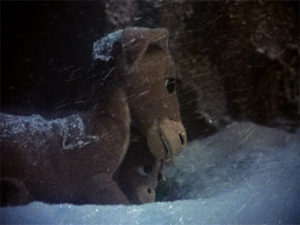
Nestor’s mother DIES. She dies. Frozen to death from exposure, the camera lingers on her snow covered corpse for longer than it probably should. Okay, forget Dumbo. This is Bambi now. This is that hard hitting emotional punch of bringing in a concept that feels way too real to prop up a rip-off of a story. I hate this. I love it in Bambi. I hate this because it knows how well it worked in Bambi and it is literally trying to copy that moment note for note. There’s just no heart in what’s supposed to be a touching moment. It’s used to lure you in, keep you here devoted to Nestor’s story which brings nothing of its own to the table, and I’m calling it out.
So Nestor the Long-Eared Donkey is now alone, lost, and desperate for anything to turn to. What an opportune moment to discover religion! Now, I again admit that I am as lost as one can possibly get when encountering biblical iconography, but I know a cherub when I see one because they’re on all the Valentine’s Day cards. It’s here where Nestor meets Tilly the cherub, and she looks like she comes right out of one of those Big Eyes paintings that hung on your great aunt’s wall. She seems remarkably dated even for 1977. Apparently cherubs inspire animals in the same way angels inspire humans, so Nestor follows Tilly because God wants him to. Tilly is only a friend because she’s not a bully. She’s pulling him in at his lowest moment.
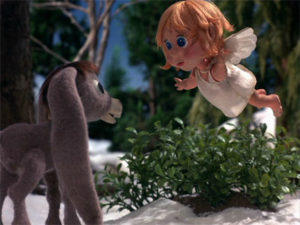
Guiding Nestor out into the desert, Nestor sees figures in the distance. Guess who. Yup, THE VIRGIN MARY HERSELF IS HERE. AGAIN. For such a revered figure in Christianity, she certainly is making the rounds of these stop-motion television specials. Her eyes are blue and surprisingly lifeless, as if Rankin-Bass were hedging their bets over whether to give her any real scope of character. May I remind you that Nestor doesn’t actually speak? So now we have multiple non-characters taking up entire scenes. It hinges solely on the strength of the narrative, which is… they walk to Bethlehem. To say I’m engaged would be a gross exaggeration.
So now it’s still Rudolph, but it’s Rudolph with Jesus. And also THE LION KING. Because Nestor sees his mother in the clouds and is guided to Bethlehem by her spirit. Okay, I know The Lion King came out later, but this is just too freaky of a coincidence. I swear I came up with the Disney angle before I even saw this part. It this just a common trope of storytelling that Disney and Rankin-Bass were pulling from? Am I just not looking hard enough to see my parents in the clouds?
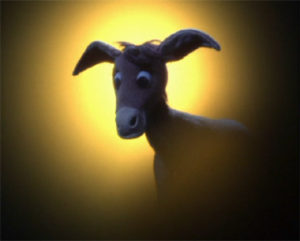
Okay, so pause here. Because I realise I never actually talked about the song. Because the song? It literally name checks Rudolph and tells you that Nestor is just as important because he “carried the first gift of Christmas” which… yes, was the Baby Jesus. I don’t normally do this, but I think you need to listen to the song itself to believe it. Here it is in what I can only assume is its definitive version:
It’s just such a perfect representation of the jealousy some people have over the secularisation of Christmas. Like, oh, you have Rudolph on your side? Well we have a Rudolph too! Only he’s not as good! Take that! And this isn’t me being critical of religion itself either. I wouldn’t even mind if Rankin-Bass just flat out told the story of Mary and Joseph! Or isn’t that a good story? You know, that thing they call the greatest story ever told? It baffles me how much they would rather skirt around that here and fool kids into watching a religious-based Christmas special than just put together a high quality story and sell it honestly. It just baffles me. Uhg.
On an ending note, it’s also baffling to see Nestor return to the farm where he started at the end. I get the cyclicity to it, but why would Nestor return? His mother is dead. Olaf chucked him out. And there were so many other places he could go! What happened to the other donkeys? You know, the ones that were taken as slaves to the Roman Empire? Are we saving that for Nestor the Long-Eared Christmas Donkey: Book II as well?

My main emotion at the conclusion of Nestor the Long-Eared Christmas Donkey was unabashed confusion and anger. I don’t think that’s right. It’s the most heartless Rankin-Bass film I’ve seen to date, more concerned with recapturing the success of an earlier classic than creating something new. Rudolph the Red-Nosed Reindeer didn’t succeed because it was CUTE ANIMAL + CHRISTMAS = $$$. On an objective scale though, I mean, the tropes they stole from Disney and themselves did work. It was entertaining on a superficial level, if not a critical one, so it actually ends up a couple rungs up from the bottom.
- Rudolph the Red-Nosed Reindeer
- Frosty the Snowman
- Santa Claus is Comin’ to Town
- Twas the Night Before Christmas
- Rudolph’s Shiny New Year
- Frosty’s Winter Wonderland
- The Year Without a Santa Claus
- Nestor the Long-Eared Christmas Donkey
- The Little Drummer Boy
- The First Christmas Snow
I’m glad we got that out of our system. It should be clear secular sailing for our final two. And next? Oh, next is going to be fun. Up next is Rudolph and Frosty’s Christmas in July!




